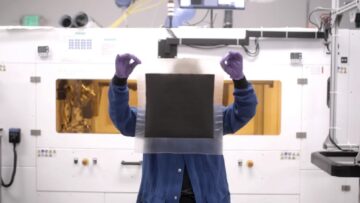
In his mid-30s, Marc Gauthier noticed a creeping stiffness in his muscles. His hand shook when trying to hold steady. He struggled to maintain his balance while walking.
Then he began to freeze in place. When strolling down narrow streets running errands, his muscles seemed to suddenly disconnect from his brain. He couldn’t take a next step.
Gauthier has Parkinson’s disease. The debilitating brain disorder gradually destroys a type of brain cell related to the planning of movement. Since the 1980s, scientists have explored multiple treatments: transplanting stem cells to replace dying brain cells, using medications to counteract symptoms, and deep brain stimulation—the use of an electrical brain implant to directly zap the brain regions that coordinate movement.
While beneficial to many people, such treatments didn’t completely help Gauthier. Even with a deep brain stimulation device and medications, he struggled to walk without freezing in place.
In 2021, he signed up for a highly experimental trial. He had a small implant inserted into his spinal cord to directly activate nerves connecting his spinal cord and leg muscles. While extensively tested in non-human primates with symptoms resembling Parkinson’s, the therapy had never been tried in humans before.
Once Gauthier adapted to the implant, he found he could stroll the banks of Lake Geneva in Switzerland without any aid after three decades living with the disease.
“I can now walk with much more confidence,” he said in a press conference. Two years after the implant, “I’m not even afraid of stairs anymore.”
Gauthier’s success suggests a new way of tackling movement disorders originating in the brain. The implant mimics the natural signal patterns the brain sends to muscles to control walking, overriding his faulty biological signals.
“There are no therapies to address the severe gait problems that occur at a later stage of Parkinson’s, so it’s impressive to see him walking,” said study author Dr. Jocelyne Bloch to Nature.
The work is an “impressive tour-de-force,” said Drs. Aviv Mizrahi-Kliger and Karunesh Ganguly at the University of California, San Francisco, who were not involved in the study.
An Old Conundrum
It’s easy to take our movement for granted. A skip across a puddle seems mundane. But for people with Parkinson’s disease, it’s a hefty challenge.
We don’t yet fully understand what triggers the disease. A number of genes have been implicated. What’s clear is that the disorder slowly robs a person of the ability to move their muscles as the associated neurons are damaged. These cells pump out dopamine—a brain chemical that’s often linked to unexpected “happy” signals, such as after a surprisingly good meal. However, dopamine has a second job: It’s a traffic controller for muscle movement.
These signals break down in Parkinson’s disease.
One way to treat Parkinson’s is to increase dopamine levels with a drug called levodopa. Deep brain stimulation is another. Here, researchers insert an electrical probe deep inside the brain (hence the name) to activate neural circuits that release dopamine. While effective, the procedure is damaging to surrounding brain tissue, often causing inflammation and scarring.
The new study avoided the brain entirely.
Finding Hot Spots
For over a decade, Dr. Grégoire Courtine at the Swiss Federal Institute of Technology in Lausanne, in collaboration with NeuroRestore, has tried to reconnect mind to muscle.
Courtine’s team previously engineered an implant that helped people with spinal cord injuries walk with minimal training. Our brain controls muscles through the spinal cord. If that highway is damaged, muscles no longer respond to neural commands. Building on their earlier work, the team sought to develop a similar implant for Parkinson’s.
But many mysteries remained: Where should the electrodes go? What level of electrical simulation is necessary to activate the neural circuits? And are muscles going to respond to those artificial signals?
Using data from monkeys and humans, both healthy and with Parkinson’s—or Parkinson’s-like symptoms in the case of the monkeys—the team trained a spinal implant to detect unusual gaits and movements common in the disease. This implant could then also stimulate the spinal cord to restore healthy walking patterns.
The implant is tiny yet powerful. Made of two eight-electrode arrays, it uses various electrical stimulation patterns to mimic the intricacies of a natural neural command. The implant is placed in the spinal cord around the small of the back, lower than prior devices. This lower placement better engages the back and leg muscles essential for maintaining balance and walking.
In monkeys chemically-induced to display Parkinson’s symptoms, the stimulator restored aspects of their gait and balance. The monkeys could move at speeds similar to healthy peers and had better posture than untreated ones. Importantly, the implant prevented them from falling when challenged with obstacles—a problem for advanced Parkinson’s patients.
One Step Forward
These encouraging results led Gauthier to volunteer as the first human participant in an ongoing trial to test spinal cord stimulation in people with Parkinson’s.
Gauthier was first diagnosed with the disorder at 36. Eight years later, he had deep brain stimulation electrodes implanted and was taking the medication levodopa. Even so, his motions were slow and rigid, and he often stumbled or fell.
To personalize his implant, the team captured hours of video of his walking patterns. They then built a model of his muscles, skeleton, and several joints, such as the hips and knees. Using the model, they trained software to compensate for any dysfunction—allowing it to decipher the user’s intent and translate it into electrical zaps in the spinal cord to support the movement.
With the spinal cord implant active, Gauthier’s gait was far closer to that of a healthy person than someone with Parkinson’s. Although most of his previous treatments could control symptoms, he could finally walk with ease along a beachside road.
These results, though promising, are from just one person. The team wants to expand the treatment to six more people with Parkinson’s next year. Also, for now, the spinal stimulator isn’t a replacement for deep brain stimulation. During the trial Gauthier had his deep brain implant on. However, adding spinal cord stimulation lowered his chances of freezing and falling.
Parkinson’s remains an enigma. The disease varies between people and changes over time. Some develop gait and motor symptoms early on; others show symptoms far later. “That’s why researchers need to test the implant in as many people as possible,” study author Eduardo Martín Moraud told El Pais.
Larger trials are necessary before bringing the treatment to the hundreds of thousands of people with Parkinson’s in the US. But for now, one man has regained his life. “My daily life has profoundly improved,” said Gauthier.
Image Credit: CHUV Weber Gilles
- SEO Powered Content & PR Distribution. Get Amplified Today.
- PlatoData.Network Vertical Generative Ai. Empower Yourself. Access Here.
- PlatoAiStream. Web3 Intelligence. Knowledge Amplified. Access Here.
- PlatoESG. Carbon, CleanTech, Energy, Environment, Solar, Waste Management. Access Here.
- PlatoHealth. Biotech and Clinical Trials Intelligence. Access Here.
- Source: https://singularityhub.com/2023/11/09/spinal-implant-helps-a-man-with-severe-parkinsons-walk-with-ease-again/
- :has
- :is
- :not
- :where
- $UP
- 2021
- 36
- a
- ability
- across
- active
- adapted
- adding
- address
- advanced
- afraid
- After
- again
- Aid
- along
- also
- Although
- an
- and
- Another
- any
- anymore
- ARE
- around
- artificial
- AS
- aspects
- associated
- At
- author
- aviv
- avoided
- back
- Balance
- Banks
- Beachside
- been
- before
- began
- beneficial
- Better
- between
- both
- Brain
- brain cells
- Break
- Bringing
- Building
- built
- but
- california
- called
- CAN
- captured
- case
- causing
- cell
- Cells
- challenge
- challenged
- chances
- Changes
- chemical
- clear
- closer
- collaboration
- Common
- completely
- Conference
- confidence
- Connecting
- control
- controller
- controls
- coordinate
- could
- counteract
- credit
- daily
- damaging
- data
- decade
- decades
- Decipher
- deep
- detect
- develop
- device
- Devices
- directly
- Disease
- disorder
- disorders
- Display
- Dont
- down
- dr
- drug
- during
- Dying
- Earlier
- Early
- ease
- easy
- Effective
- eight
- el
- encouraging
- engages
- Enigma
- entirely
- essential
- Even
- Expand
- experimental
- Explored
- extensively
- Falling
- far
- faulty
- Federal
- Finally
- First
- For
- found
- Francisco
- Freeze
- Freezing
- from
- fully
- Geneva
- Go
- going
- good
- gradually
- granted
- had
- hand
- Have
- he
- healthy
- help
- helped
- helps
- hence
- here
- highly
- Highway
- him
- his
- hold
- HOT
- HOURS
- However
- HTML
- HTTPS
- human
- Humans
- if
- implicated
- importantly
- impressive
- improved
- in
- Increase
- inflammation
- inside
- Institute
- intent
- into
- intricacies
- involved
- IT
- Job
- just
- just one
- lake
- later
- Led
- Level
- levels
- Life
- linked
- living
- longer
- lower
- lowered
- made
- maintain
- maintaining
- man
- many
- many people
- medication
- medications
- mind
- minimal
- model
- more
- most
- motions
- Motor
- move
- movement
- movements
- much
- multiple
- muscle
- name
- narrow
- Natural
- Nature
- necessary
- Need
- Neural
- Neurons
- never
- New
- next
- NIH
- no
- now
- number
- occur
- of
- often
- Old
- on
- ONE
- ones
- ongoing
- or
- originating
- Others
- our
- out
- over
- overriding
- Parkinson’s Disease
- participant
- patients
- patterns
- peers
- People
- person
- personalize
- Place
- placed
- placement
- planning
- plato
- Plato Data Intelligence
- PlatoData
- possible
- powerful
- press
- previous
- previously
- Prior
- probe
- Problem
- problems
- procedure
- profoundly
- promising
- pump
- reconnect
- regions
- related
- release
- remained
- remains
- replace
- replacement
- researchers
- resembling
- Respond
- restore
- restored
- Results
- rigid
- road
- running
- Said
- San
- San Francisco
- scientists
- Second
- see
- seemed
- seems
- sends
- several
- severe
- shook
- should
- show
- Signal
- signals
- signed
- similar
- simulation
- since
- SIX
- slow
- Slowly
- small
- So
- Software
- some
- Someone
- sought
- speeds
- Stage
- steady
- Stem
- stem cells
- Step
- streets
- Study
- success
- such
- Suggests
- support
- Surrounding
- Swiss
- switzerland
- Symptoms
- tackling
- Take
- taking
- team
- Technology
- test
- tested
- than
- that
- The
- their
- Them
- then
- therapies
- therapy
- These
- they
- this
- those
- though?
- thousands
- three
- Through
- time
- tissue
- to
- traffic
- trained
- Training
- translate
- treat
- treatment
- treatments
- trial
- trials
- tried
- trying
- two
- type
- understand
- Unexpected
- university
- University of California
- unusual
- us
- use
- uses
- using
- various
- Video
- volunteer
- walk
- walking
- wants
- was
- Way..
- were
- What
- when
- while
- WHO
- why
- with
- without
- Work
- year
- years
- yet
- zephyrnet











